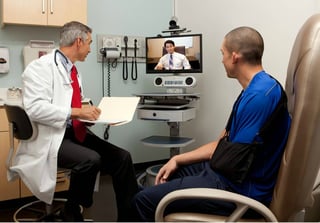5 Things You Need to Know About Telemedicine in Emergency Medicine
Patients today are more tech-savvy than ever. As a society we expect information on-the-spot. We are able to access any and all information with a simple swipe and search of our smartphones and this desire extends past finding the directions to our nearest emergency care center.
According to the American Telemedicine Association (ATA), consumers want telemedicine. The greatest impact of telemedicine is on the patient, their family and their community. Using telemedicine technologies reduces travel time and related stresses for the patient. Such services offer patients the access to providers that might not be available otherwise, as well as medical services without the need to travel long distances.
While it's popularity is rapidly increasing, telemedicine is not a new idea. Starting out over 40 years ago with demonstrations of hospitals extending care to patients in remote areas, the use of telemedicine has spread rapidly and is now becoming integrated into the ongoing operations of hospitals, specialty departments, home health agencies, private physician offices as well as consumer’s homes and workplaces.
The ATA formally defines telemedicine as the use of medical information exchanged from one site to another via electronic communications to improve a patient's clinical health status. Telemedicine includes a growing variety of applications and services using two-way video, email, smart phones, wireless tools and other forms of telecommunications technology.
The ATA has historically considered telemedicine and telehealth to be interchangeable terms, encompassing a wide definition of remote healthcare. Patient consultations via video conferencing, transmission of still images, e-health including patient portals, remote monitoring of vital signs, continuing medical education, consumer-focused wireless applications and nursing call centers, among other applications, are all considered part of telemedicine and telehealth.
How would telemedicine in emergency medicine effect services? Using information from the American College of Emergency Physicians (ACEP) and ATA, we've compiled the five things you need to know.
1. Improved Access
For over 40 years, telemedicine has been used to bring healthcare services to patients in distant locations. Not only does telemedicine improve access to patients but it also allows physicians and health facilities to expand their reach, beyond their own offices. Given the provider shortages throughout the world--in both rural and urban areas--telemedicine has a unique capacity to increase service to millions of new patients.
The recent resurgence of telemedicine has been sparked by a variety of tensions in the health care industry, including: competition among providers prompted by the need to become profitable; the need to reduce the cost of care; and the notion that a broader network of patients can be built and managed more easily by using telemedicine strategies. Telemedicine has the potential to increase patient volume, lower cost, and generate greater market share.
Telemedicine is currently used sporadically in the emergency department, and a review of current literature reveals little published information on how practice patterns or revenue streams have changed since its introduction. Logistically, the emergency department may be an ideal place for telemedicine set-up as it serves as a meeting place for physicians that is always open, and is therefore able to accommodate the sporadic influx of telemedicine consults. ED telemedicine, as with all telemedicine applications, may initially flourish most in rural areas.
2. Cost Efficiencies & Reimbursement
New health care technologies such as telemedicine are judged on whether they improve health outcomes and lower costs. For payors, the costs of easier access to specialists, as would be enabled by telemedicine, may be substantially increased. At least one estimate projects that Medicare reimbursement alone for telemedicine services could increase that budget by $30 billion over the first three to five years of use.
In a fee-for-service environment, the impact of telemedicine reimbursement is of prime importance. Without proper reimbursement, hospitals will not be willing to incur infrastructure development costs -- a full-service, state-of-the-art telemedicine spoke suite costs between $70-95,000 -- and consulting physicians will likely not be interested in providing their services. However, in a risk-bearing, prepaid environment, issues of reimbursement become inconsequential.
Rather, the focus becomes whether telemedicine enables effective medical care delivery at a reduced cost compared to traditional, face-to-face care. Telemedicine offers the potential to lower fixed costs by using less practitioners more efficiently.
3. Employment Opportunities
There is some concern that telemedicine may cut into emergency physician employment opportunities. It may decrease the demand for physicians to staff all sites of emergency care, especially at spoke sites, by enabling mid-level providers to staff the locations instead. A nurse practitioner, for example, might work remotely at a moderate acuity facility, having as a back up the ability to consult a hub site staffed with emergency physicians for more complex cases.
Two market drivers will influence the evolution of mid-level provider staffing practices. The first is the supply of emergency physicians available to meet staffing demands, and their willingness to work in less desirable geographic areas. The second is the spread of cost pressures from the urban market, where they first flourished, to the rural market. Decreased reimbursement, coupled with difficulty attracting quality providers, creates a demand for mid-level providers in rural regions. The use of mid-level providers in clinical settings where telemedicine is used is new, and ultimate cost-effectiveness has yet to be proven. In the long term, the sum of costs incurred from telemedicine infrastructure set-up and operation, fees paid out for consultations sought by midlevel providers, and possibly higher malpractice claims totals (if indeed malpractice risk is higher with mid-level providers) may outweigh any short-term gains from decreased fixed costs of staffing.
In addition to decreasing demand for physicians at spoke sites, an ED telemedicine network may also lessen demand at hub sites. Consults from a spoke site could conceivably be routed to the hub site within the network that, at that exact moment, has excess capacity due to a temporary lull in patient flow. The overall effect of this would be to drive up the efficiency of hub site physicians by decreasing down time.
4. Legal Liability
To date, telemedicine has largely been limited to intrastate medicine, and there is currently no case law regarding the interstate practice of medicine. In what state the case law should be applied (i.e. the state where the telemedicine physician delivers care or the state where the patient receives care) remains an unanswered question. Many states have expressed reluctance to allow physicians to practice medicine across state lines, as would occur with telemedicine, without formally passing state licensing exams. Some states have already passed legislation forbidding it. Telemedicine proponents argue for the development of specific legislation allowing physicians to practice via telemedicine across state lines without having to undergo formal, state-by-state licensing, but nothing has yet been formalized.
Further questions arise regarding joint liability and product liability. Will both the presenting and consulting physician be held liable in cases of negligence? Will the maker of telemedical devices be named in a suit? FDA regulatory policies regarding telemedicine hardware and software applications are evolving but unclear.
5. Cultural Barriers
The majority of physicians have appeared reluctant to embrace telemedicine despite its relatively obvious potential applications. Telemedicine is not a standard of care from physicians’ perspective at present, and will not be until good scientific data demonstrating benefits is generated. Administrators may see the economic benefits readily, but without physician acceptance telemedicine will not flourish.
The same holds true for patient acceptance. Will patients value the ability to receive care quickly and easily more than they value the face-to face interaction with physicians? According to the ATA, over the past 15 years, study after study has documented patient satisfaction and support for telemedical services. Studies have consistently shown that the quality of healthcare services delivered via telemedicine are as good those given in traditional in-person consulations. In some specialties, particularly in mental health and ICU care, telemedicine delivers a superior product, with greater outcomes and patient satisfaction. Again, universal acceptance depends on patients realizing, and experiencing first-hand, the benefits of ED telemedicine if it indeed exists.
Sources: 1. ACEP: Telemedicine in Emergency Medicine 2. American Telemedicine Association




